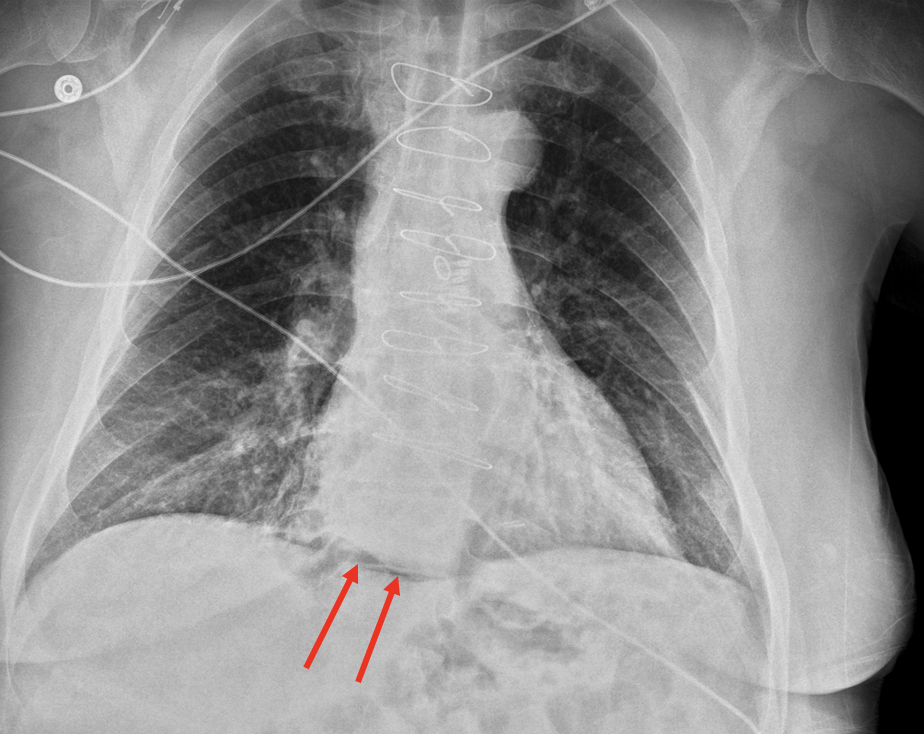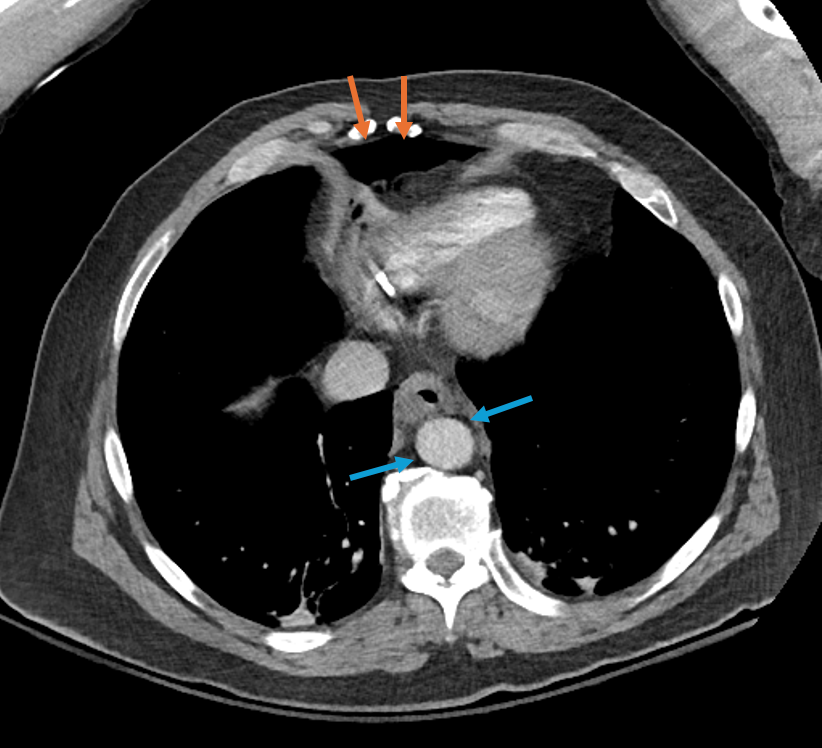Monday Poster Session
Category: Interventional Endoscopy
P3616 - Retroperitoneal Free Air Post Peroral Endoscopic Myotomy: It Can Happen!
Monday, October 27, 2025
10:30 AM - 4:00 PM PDT
Location: Exhibit Hall

Malique Delbrune, MD (he/him/his)
University of Colorado Anschutz Medical Campus
Aurora, CO
Presenting Author(s)
Malique Delbrune, MD1, Thomas Enke, MD2, Mohammad Bilal, MD, FACG3
1University of Colorado Anschutz Medical Campus, Aurora, CO; 2University of Colorado, Aurora, CO; 3University of Colorado Anschutz Medical Campus, Denver, CO
Introduction: Peroral endoscopic myotomy (POEM) is routinely performed for the treatment of achalasia. Imaging findings after POEM such as pneumomediastinum and pneumoperitoneum are commonly seen and are typically benign. A less common finding is retroperitoneal air, and the clinical significance is not as well described. We present a case of a 60-year-old male with achalasia who underwent POEM with severe post-procedural pain prompting further evaluation.
Case Description/
Methods: A 60-year-old male with type III achalasia previously treated with botulinum toxin injection underwent POEM. A selective circular myotomy for the spastic segment and full thickness myotomy at the lower esophageal sphincter was performed. Final myotomy measured 10 cm in length and extended 1 cm into the gastric cardia. The procedure was challenging due to severe submucosal fibrosis, potentially related to prior botulinum toxin treatment, however no intra-procedural adverse events occurred. He was started on intravenous antibiotics consistent with standard practices at our intuition. Post-procedure course was complicated by severe chest and abdominal pain and tachypnea. Chest x-ray revealed a lucency in the inferior mediastinum consistent with pneumomediastinum, as expected post-POEM (Figure 1). Due to symptom severity, a computed tomography scan of the chest and abdomen was obtained which revealed small volume pneumomediastinum and free air within the retroperitoneum (Figure 2). He remained afebrile and hemodynamically stable. His pain quickly improved with intravenous analgesics and completely resolved by post-operative day one. No esophageal leak was seen on esophagogram obtained post-procedure day one, and the patient was discharged.
Discussion: An understanding of expected radiographic findings post-POEM is important when evaluating a potential adverse event. While pneumomediastinum and pneumoperitoneum are expected findings post-POEM, the presence of retroperitoneal free air post-POEM is less commonly seen. Our case highlights that retroperitoneal free air can be seen post-POEM, and these findings may not warrant further intervention in the absence of an esophageal leak identified on imaging.

Figure: Chest X-ray with lucency in inferior mediastinum (red arrows)

Figure: Figure 2. Computed tomography of the chest with intravenous contrast demonstrating pneumomediastinum (see orange arrows) and retroperitoneal air (see blue arrows).
Disclosures:
Malique Delbrune indicated no relevant financial relationships.
Thomas Enke indicated no relevant financial relationships.
Mohammad Bilal: Boston Scientific – Consultant. Cook endoscopy – Paid speaker. Steris Endoscopy – Consultant.
Malique Delbrune, MD1, Thomas Enke, MD2, Mohammad Bilal, MD, FACG3. P3616 - Retroperitoneal Free Air Post Peroral Endoscopic Myotomy: It Can Happen!, ACG 2025 Annual Scientific Meeting Abstracts. Phoenix, AZ: American College of Gastroenterology.
1University of Colorado Anschutz Medical Campus, Aurora, CO; 2University of Colorado, Aurora, CO; 3University of Colorado Anschutz Medical Campus, Denver, CO
Introduction: Peroral endoscopic myotomy (POEM) is routinely performed for the treatment of achalasia. Imaging findings after POEM such as pneumomediastinum and pneumoperitoneum are commonly seen and are typically benign. A less common finding is retroperitoneal air, and the clinical significance is not as well described. We present a case of a 60-year-old male with achalasia who underwent POEM with severe post-procedural pain prompting further evaluation.
Case Description/
Methods: A 60-year-old male with type III achalasia previously treated with botulinum toxin injection underwent POEM. A selective circular myotomy for the spastic segment and full thickness myotomy at the lower esophageal sphincter was performed. Final myotomy measured 10 cm in length and extended 1 cm into the gastric cardia. The procedure was challenging due to severe submucosal fibrosis, potentially related to prior botulinum toxin treatment, however no intra-procedural adverse events occurred. He was started on intravenous antibiotics consistent with standard practices at our intuition. Post-procedure course was complicated by severe chest and abdominal pain and tachypnea. Chest x-ray revealed a lucency in the inferior mediastinum consistent with pneumomediastinum, as expected post-POEM (Figure 1). Due to symptom severity, a computed tomography scan of the chest and abdomen was obtained which revealed small volume pneumomediastinum and free air within the retroperitoneum (Figure 2). He remained afebrile and hemodynamically stable. His pain quickly improved with intravenous analgesics and completely resolved by post-operative day one. No esophageal leak was seen on esophagogram obtained post-procedure day one, and the patient was discharged.
Discussion: An understanding of expected radiographic findings post-POEM is important when evaluating a potential adverse event. While pneumomediastinum and pneumoperitoneum are expected findings post-POEM, the presence of retroperitoneal free air post-POEM is less commonly seen. Our case highlights that retroperitoneal free air can be seen post-POEM, and these findings may not warrant further intervention in the absence of an esophageal leak identified on imaging.

Figure: Chest X-ray with lucency in inferior mediastinum (red arrows)

Figure: Figure 2. Computed tomography of the chest with intravenous contrast demonstrating pneumomediastinum (see orange arrows) and retroperitoneal air (see blue arrows).
Disclosures:
Malique Delbrune indicated no relevant financial relationships.
Thomas Enke indicated no relevant financial relationships.
Mohammad Bilal: Boston Scientific – Consultant. Cook endoscopy – Paid speaker. Steris Endoscopy – Consultant.
Malique Delbrune, MD1, Thomas Enke, MD2, Mohammad Bilal, MD, FACG3. P3616 - Retroperitoneal Free Air Post Peroral Endoscopic Myotomy: It Can Happen!, ACG 2025 Annual Scientific Meeting Abstracts. Phoenix, AZ: American College of Gastroenterology.

